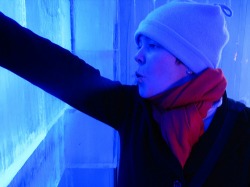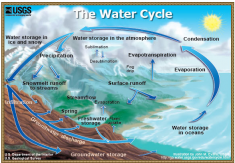Research
In a report (1983) by Cosgrove and Osborne on children's ideas (ages 8-17) on condensation, misconceptions about condensation included:
1) water comes through the glass on a sealed ice jar.
2) coldness comes through the glass on a sealed ice jar.
3) the cold surface and dry air react to form water
4) water in the air sticks to the glass
Kind V. Beyond Appearances: Students’ Misconceptions About Basic Chemical Ideas (2nd ed.) (online). http://www.chemsoc.org/LearnNet/rsc/miscon.pdf [21 August 2006].
In this ISJE journal, different levels of understanding of condensation were found among second year chemical engineering students (ages range from 18-20 years). These understandings were macroscopic and superficial. Students with a macroscopic understanding explained condensation as simply a phase change from gas to liquid. Students with a microscopic understanding explained condensation in terms of the particle nature of matter (collisions and energy loss).
One student example was: "Obviously, on the molecular level, somehow maybe there’s collisions with the sides of the container and there’s loss of energy … maybe that’s causing the condensation." (Alex)
Gopal, Hemant, Kleinsmidt, Jacques, Case, Jennifer, & Musonge, Paul. (2004). An Investigation of tertiary students' understanding of evaporation, condensation and vapour presseare. research report. International Journal of Science Education, 26 (13), Retrieved from http://dx.doi.org/10.1080/09500690410001673829 doi: 10.1080/09500690410001673829.
1) water comes through the glass on a sealed ice jar.
2) coldness comes through the glass on a sealed ice jar.
3) the cold surface and dry air react to form water
4) water in the air sticks to the glass
Kind V. Beyond Appearances: Students’ Misconceptions About Basic Chemical Ideas (2nd ed.) (online). http://www.chemsoc.org/LearnNet/rsc/miscon.pdf [21 August 2006].
In this ISJE journal, different levels of understanding of condensation were found among second year chemical engineering students (ages range from 18-20 years). These understandings were macroscopic and superficial. Students with a macroscopic understanding explained condensation as simply a phase change from gas to liquid. Students with a microscopic understanding explained condensation in terms of the particle nature of matter (collisions and energy loss).
One student example was: "Obviously, on the molecular level, somehow maybe there’s collisions with the sides of the container and there’s loss of energy … maybe that’s causing the condensation." (Alex)
Gopal, Hemant, Kleinsmidt, Jacques, Case, Jennifer, & Musonge, Paul. (2004). An Investigation of tertiary students' understanding of evaporation, condensation and vapour presseare. research report. International Journal of Science Education, 26 (13), Retrieved from http://dx.doi.org/10.1080/09500690410001673829 doi: 10.1080/09500690410001673829.
Examples beyond cup, mirror, and toast sweat:
1. Condensation on cottage windows submitted by flickr user: lumierefl
2. Condensation occurring on cold, winter day (breathing) submitted by flickr user: Simon Aughton
3. Opening up the refrigerator door submitted by flickr user: thisisbrian
4. Condensation on a camera lens submitted by flickr user: Colin Purrington
5. The Water Cycle: credit - John M. Evans, USGS
2. Condensation occurring on cold, winter day (breathing) submitted by flickr user: Simon Aughton
3. Opening up the refrigerator door submitted by flickr user: thisisbrian
4. Condensation on a camera lens submitted by flickr user: Colin Purrington
5. The Water Cycle: credit - John M. Evans, USGS
Additional Information
For additional information on the process of condensation, check out the resources below!
1. WatchKnow - Video for kids to learn from:
http://www.watchknow.org/Video.aspx?VideoID=7237
2. Condensation Around the Home - Where is it? How can you control it?
http://www.diydata.com/problem/condensation/condensation.php
3. Reasons for Condensation Interior and Exterior Locations
http://www.sunrisewindows.com/condensation.html
4. Molecular Motion determines water's state
http://www.usatoday.com/weather/tg/wevapcon/wevapcon.htm
5. Condensation of your exhaled breath
http://www.sciencebits.com/exhalecondense
6.Water Cycle
http://ga.water.usgs.gov/edu/watercyclesummary.html
1. WatchKnow - Video for kids to learn from:
http://www.watchknow.org/Video.aspx?VideoID=7237
2. Condensation Around the Home - Where is it? How can you control it?
http://www.diydata.com/problem/condensation/condensation.php
3. Reasons for Condensation Interior and Exterior Locations
http://www.sunrisewindows.com/condensation.html
4. Molecular Motion determines water's state
http://www.usatoday.com/weather/tg/wevapcon/wevapcon.htm
5. Condensation of your exhaled breath
http://www.sciencebits.com/exhalecondense
6.Water Cycle
http://ga.water.usgs.gov/edu/watercyclesummary.html





